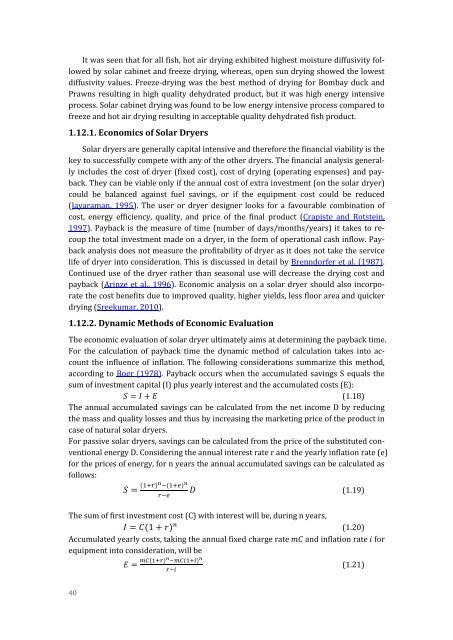Solar Drying: Fundamentals,Applications and Innovations - National ...
Solar Drying: Fundamentals,Applications and Innovations - National ...
Solar Drying: Fundamentals,Applications and Innovations - National ...
You also want an ePaper? Increase the reach of your titles
YUMPU automatically turns print PDFs into web optimized ePapers that Google loves.
It was seen that for all fish, hot air drying exhibited highest moisture diffusivity followed<br />
by solar cabinet <strong>and</strong> freeze drying, whereas, open sun drying showed the lowest<br />
diffusivity values. Freeze-drying was the best method of drying for Bombay duck <strong>and</strong><br />
Prawns resulting in high quality dehydrated product, but it was high energy intensive<br />
process. <strong>Solar</strong> cabinet drying was found to be low energy intensive process compared to<br />
freeze <strong>and</strong> hot air drying resulting in acceptable quality dehydrated fish product.<br />
1.12.1. Economics of <strong>Solar</strong> Dryers<br />
<strong>Solar</strong> dryers are generally capital intensive <strong>and</strong> therefore the financial viability is the<br />
key to successfully compete with any of the other dryers. The financial analysis generally<br />
includes the cost of dryer (fixed cost), cost of drying (operating expenses) <strong>and</strong> payback.<br />
They can be viable only if the annual cost of extra investment (on the solar dryer)<br />
could be balanced against fuel savings, or if the equipment cost could be reduced<br />
(Jayaraman, 1995). The user or dryer designer looks for a favourable combination of<br />
cost, energy efficiency, quality, <strong>and</strong> price of the final product (Crapiste <strong>and</strong> Rotstein,<br />
1997). Payback is the measure of time (number of days/months/years) it takes to recoup<br />
the total investment made on a dryer, in the form of operational cash inflow. Payback<br />
analysis does not measure the profitability of dryer as it does not take the service<br />
life of dryer into consideration. This is discussed in detail by Brenndorfer et al. (1987).<br />
Continued use of the dryer rather than seasonal use will decrease the drying cost <strong>and</strong><br />
payback (Arinze et al., 1996). Economic analysis on a solar dryer should also incorporate<br />
the cost benefits due to improved quality, higher yields, less floor area <strong>and</strong> quicker<br />
drying (Sreekumar, 2010).<br />
1.12.2. Dynamic Methods of Economic Evaluation<br />
The economic evaluation of solar dryer ultimately aims at determining the payback time.<br />
For the calculation of payback time the dynamic method of calculation takes into account<br />
the influence of inflation. The following considerations summarize this method,<br />
according to Boer (1978). Payback occurs when the accumulated savings S equals the<br />
sum of investment capital (I) plus yearly interest <strong>and</strong> the accumulated costs (E):<br />
S = I + E (1.18)<br />
The annual accumulated savings can be calculated from the net income D by reducing<br />
the mass <strong>and</strong> quality losses <strong>and</strong> thus by increasing the marketing price of the product in<br />
case of natural solar dryers.<br />
For passive solar dryers, savings can be calculated from the price of the substituted conventional<br />
energy D. Considering the annual interest rate r <strong>and</strong> the yearly inflation rate (e)<br />
for the prices of energy, for n years the annual accumulated savings can be calculated as<br />
follows:<br />
S = (1+r)n −(1+e) n<br />
D (1.19)<br />
r−e<br />
The sum of first investment cost (C) with interest will be, during n years,<br />
I = C(1 + r) n (1.20)<br />
Accumulated yearly costs, taking the annual fixed charge rate mC <strong>and</strong> inflation rate i for<br />
equipment into consideration, will be<br />
E = mC(1+r)n −mC(1+i) n<br />
(1.21)<br />
r−i<br />
40

















